May 2009.
Central PA
Squishing down the bags of clothes and fishing gear wedged between the coolers to clear the bed rails, we stretched and snapped down the cover, shut the tail gate, and piled in. Cathy Nutter, Ken Bowyer and I had been waiting anxiously for days to get underway and were all talking at once about weather conditions, stream levels, and hatch reports. Strapped in for takeoff we headed for State College, Pennsylvania rendezvousing with Tim Bowers and William Amland along the way to wolf down platters of pancakes, omelets, and home fries, filling up the cracks with hot coffee.
When we reached Fisherman’s Paradise around noon it was still only 54° with bright sunny skies. The parking lot was already full, so we parked outside the gate and geared up there. As I pulled on my waders a large Mayfly flew by and landed in the leaves behind me, a March Brown spinner with caramel colored ribbing and black mottled wings stayed still almost long enough for me to get a picture before fluttering off.
Waders on and rods strung up, we decided to walk the half a mile to a spot that was productive for us last year. Getting to the foot bridge we found Will and Tim in mid stream intently working the seams. Finding no action, they were off in a few minutes to explore for better water upstream leaving us to it. Two hours later, with only an occasional fly lifting off the surface, a rising trout even rarer, the three of us climbed out hungry and thirsty to take a long break on the bridge. We lounged in the sun eating and drinking and watching the water for any signs of fish and looking for bugs in the surrounding foliage.
 |
This is really a beautiful time to be in central Pennsylvania; cool comfortable temperatures, everything decked out in bright spring greens. Driving through the mountain valleys to the various fishing spots we saw black and white Holstein cows dotting pastures shining bright in the afternoon sun amidst a patchwork of freshly disked fields. The roadsides were nicely colored up with clumps of white and lavender phlox that stuck up a foot or more over the grass and weeds, and chestnut trees laden with cone shaped blossoms festooned farm yards that Cathy said reminded her of southern Bavarian Bier Gartens.
Standing on the bridge the water was mesmerizing; sun sparkled and reflected the deep blue sky gradually getting darker and greener along the edge shaded by the canopy of trees above. Maybe it wasn’t the best fishing weather, but it was sure very pleasant.
Resuming fishing, I looked up around 5pm to see Mike Abramowitz and Robert Simpson come trooping across the bridge. During the next hour we spread out along a half mile section of stream in anticipation of the hatch. Stepping up on the bank to repair my leader and add new tippet I noticed some sulphur duns in good numbers just starting to come off tight against the bank. I looked at my watch - it was ten after six, sulphur time! Tying on an emerger I stepped back into the water just as the first rises started and sneaked into casting position. I looked up when I heard Tim calling from below. He was 50 yards downstream waving for me to come down saying he had fish rising all around. I waved him off saying thanks but no need I’ve got rising fish here, too.
After losing the first two, the fish didn’t want the emerger anymore, and I stopped to tie on a different pattern. Looking around I could see Fish rising everywhere. I could see little splashy rises all the way up to the bend where Robert was releasing one, to down past Tim who was playing one into calmer water. The fish were a lot more gullible and easier to fool in the first 20 minutes of the hatch, and after those first quick hook ups they became more selective and I then spent the next two hours changing flies, finding one they would rise to a couple of times then ignore, sending me back to the box. At one point I hit on a spinner I had tied on last year’s trip, a #16 dusty pink spinner with blue dun hackle clipped to ride flat on the water. For a little while at least I was hooking fish with some regularity, while three grouse drummed background music for me on the mountainside above.
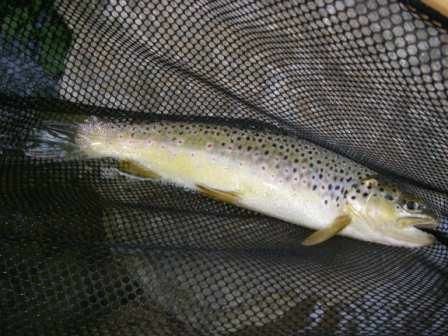 |
Soon after they refused that pattern and I was running out of options. I couldn’t get a look at anything with white or cream hackle; which was exactly what Ken was taking fish on 75 yards upstream, and Cathy another 75 yards above him. Later, all eleven of us compared notes over burgers and fries at Hooters. We had a pretty good evening. During the day, only a few fish were caught, Robert and I both took a fish on a pheasant tail and Ken got one an Elk Hair Caddis, and I think Tim and Will both had some luck. However, what the afternoon lacked, the evening more than made up for. For over two hours the Sulphurs poured off in droves bringing hungry fish up with them until it was too dark to see and only the sound of their rises to guide the cast. Their selectiveness was really frustrating at times, but everybody caught fish, and in the classic style of casting to specific risers picking them off. Most reported four to six fish landed with many more lost. The flies that were the most productive during the hatch were the orange/yellow biot body spinner with dun hackle in # 14 & #16, orange parachute also in #14, and spinners with yellow bodies and white hackle in #14 & #16.
Back at Jim Keil’s hunting cabin where we were staying, the scotch and theories of woulda’, coulda’, shoulda’, flowed well into the night. With a cold clear morning forecasted there was no need to get up early, so folks stayed up talking fishing then straggled off to bed. Next morning most of us decided to take a look at Spruce Creek or the Little Juniata. Cathy, Ken, and I hit the fly shop in Spruce Creek at the confluence of with the Little J first, and then drove up to the George Harvey public access for a look. It’s a beautiful little creek, but with the sun up high and full on the water we decided to hunt up some gas and lunch and head for the Little J.
At Rothrock State Forest parking area near Barree, we ate the Italian subs that we scored at the gas station for lunch. Before we left for the hike over the mountain to the area of the Little J that has graced many a magazine page, Jim Keil, Robert Simpson, Mike Abramowitz, and Jim Arnold drove in to check things out. Then they pushed on for the Tyrone section where Keil said they hoped to find more shaded water.
 |
 |
I’m a little fuzzy on the details, but the urge to go swimming became overwhelming for Tim and Jim A. at about the same time though they were a mile or so apart. From all accounts, the water is still a might too cool for that activity. On river, Robert spotted a mink working the shoreline, and Jim K. said he did well but all his fish were taken on sub-surface flies, nothing on top. For the rest of us on the Little J, success ranged from two to six fish. I know Cathy had a late spurt hooking seven and landing five in some fast water during the last hour, Ken and I only landed two apiece. Not having much luck where I was, and determining I needed a change of scenery anyway, I made my way around the bottom of the island we were fishing and into the narrower and faster water on the side closest the path. Along the way I waded into the largest cloud of female spinners I’ve ever been in. Hundreds if not thousands of them were suspended six to eight feet above the stream doing their undulating dance to entice the boys who hadn’t shown up as yet. As I waded through, they would flutter a few feet away then move back around me when I stopped, their bright yellow/orange egg sacs clearly visible. As it turned out, the water on that side of the island is too rowdy and the rocks too slick to navigate. I was forced to fish from the bank making awkward across the body casts that sometimes ended in tangles with streamside brush, but which eventually rewarded me with my largest fish, a fat sixteen incher I stalked and took on a dusty pink spinner rising under a bush overhanging the stream.
I think Robert and Tim had the best luck on the J with six apiece, the biot spinner making magic again for Robert, but it was Dick, back at Benner’s on Spring Creek, who really tore it up landing eight fish - one a seventeen incher.
That night back at the cabin, after our group found the best Rueben sandwiches for supper at a café/tavern in Alexandria, the talk turned to the various flies spotted and the techniques used to get a rise. The fish were proving challenging and everybody was enjoying it. The question was bandied about whether missed fish were actually taking the fly as it looked to us, or, just slapping at it. One theory was we were just too slow on the hook set, another too fast, but I hooked one in the gill plate making me wonder if they weren’t just smacking it instead of biting it. Dick was explaining his curve cast technique to Cathy and Jim A. on how to achieve the proper drift, while Jim K. spread out the dozen to fifteen flies he had used that day on a paper plate to dry pointing out the top producers.
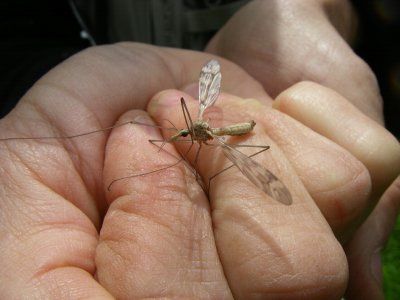 Cranefly |
 Beetle? |
 Grey Fox or Ginger Quill #14 |
 Sulphur Dun trying the scotch! |
 Black Caddis #12 |
 Two Little Black Caddis #20 |
The next morning the fly tying vices were out and while Mike demonstrated a knot to Will and Tim, the talk on flies continued. Most of us had seen a larger lighter yellowish to orange Sulphur coming off sporadically among the smaller Ephemerella invaria. I suggested the Pale Morning Dun, Ephemerella infrequens, but Dick said nope, that’s a western species and a counterpart to the eastern Sulphur. Jim K. Suggested a Cahill, Stenonema ithica, but according to Hatches II it’s too early. It’s probable the flies were Ephemerella rotunda, a Sulphur colored fly that I think may have been reclassified as a Subvaria, but a size larger whose emergence overlaps the invarias’ and usually comes off earlier in the day. The other discussion revolved around a fly George had seen that was similar to a March Brown, Stenonema Vicarium, but at least two sizes smaller. I had a picture of one I found clinging to the underside of a leaf while retrieving a snagged fly, and was able to identify it as a Stenonema Fuscum, or Grey Fox, or since a spinner, a Ginger Quill. I heard an angler at Fisherman’s Paradise fly shop later that morning saying the Grey Fox hatch a couple of weeks earlier was as good as or better than this year’s Sulphur hatch. If not in numbers, then I guess in the eagerness of the fish to take them. Other major hatches encountered were Crane flies ranging in size from #16 to # 8, a small Black Caddis in #20 that were literally all over the bushes on the Little J, a larger Black Caddis in #10 on the J, and a #16 Tan Caddis that came off everywhere throughout the day and among the evening Sulphurs, and, of course, the ever present Midges.
Tuesday afternoon had us all somewhere on Spring Creek in hopes of a repeat of Sunday night. For me it wasn’t. The same fish in the same place seemed to be even more selective than before. I had a full patch of refused flies with only the Rusty Spinner in #16 producing a fish, and after a half dozen drifts with it, they quit looking at it. An hour later I could see Ken working his way down to me and when he got within range I asked him, “How goes it?” He said, “no good”. I told him to tie on a Rusty Spinner, but he said I had to guarantee him a fish first. I guaranteed a look the first couple of casts then all bets were off. We both tied one on and both got hook ups immediately. Ken landed his, I lost mine, but I hooked two more landing one after discovering if I targeted fish at the lip of the pool they didn’t have time to give it as much scrutiny as those in mid stream.
Robert reported catching trout on wet flies for the first time, taking one on a #14 partridge and orange, and two on a partridge and yellow. Tim said he used a multitude of flies but got five more for a total of sixteen, just one less than Dick’s seventeen which I think was the largest total reported this trip.
 |
We had a great time, and even though the fish were pretty selective, I think the eleven of us netted somewhere around a hundred fish, probably hooking and losing twice that many more. No real big fish were taken, I think the three largest were Dick’s 17 incher, my 16, and Tim’s 15. Most of the fish ranged from ten to twelve inches, some in the thirteen and fourteen range. Water conditions were near perfect, and while the weather would have been better for picnicking, it was still a great time to be outside.
The following is a 7 minute video of the trip.
May 09 Sulphur Outing from Dennis Covert and Ken Bowyer on Vimeo.
Dennis Covert
Outings
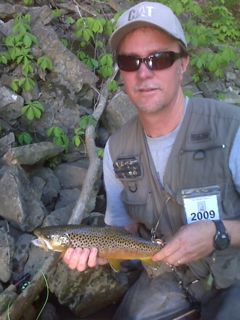 One of Tim Bowers |
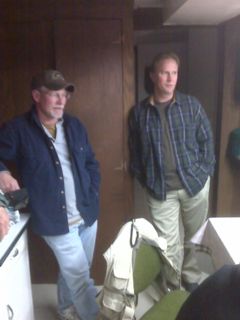 Dennis and Tim |
 Jim Arnold, Dick Friis, & Mike Abramowitz |
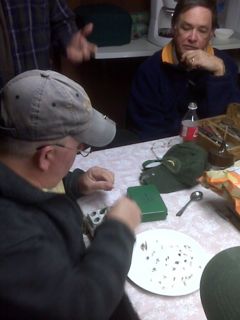 Robert Simpson watches Jim Keil sort through his flies |
 Spring Creek at Fisherman's Paradise |
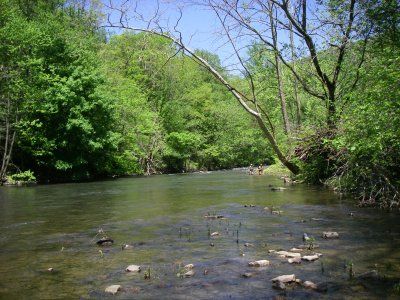 Little Juniata at Rothrock State Forest near Barree |